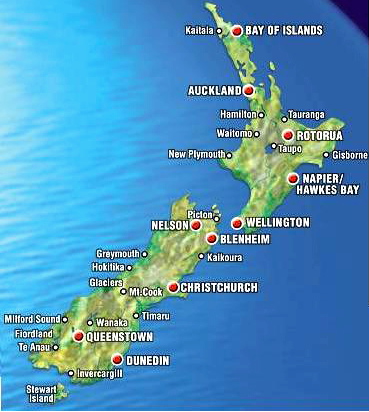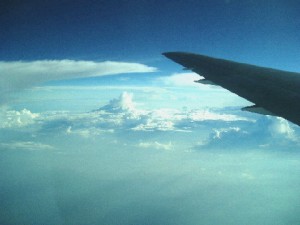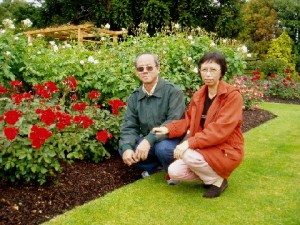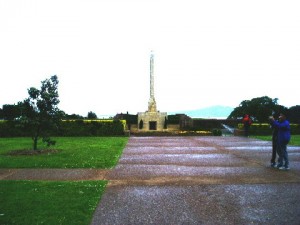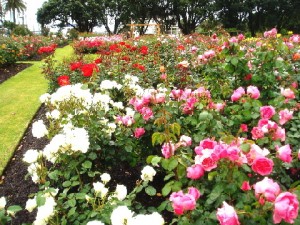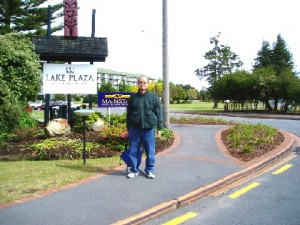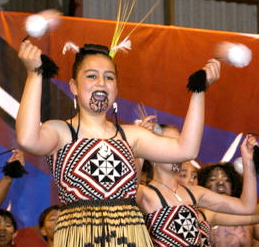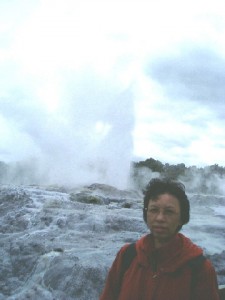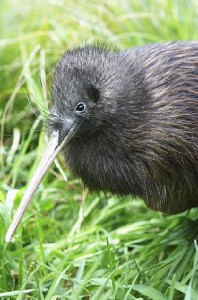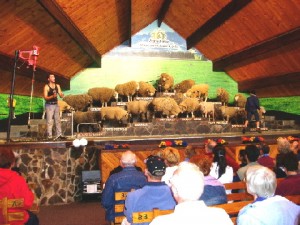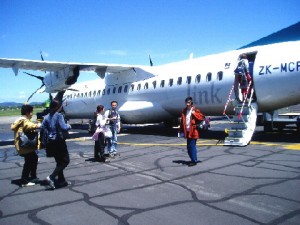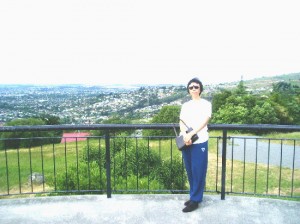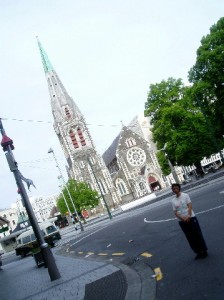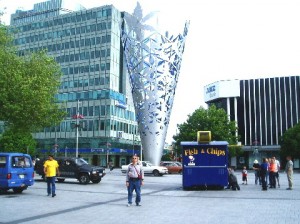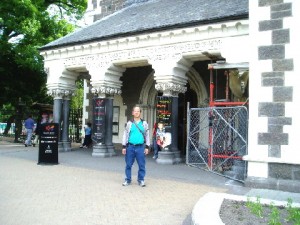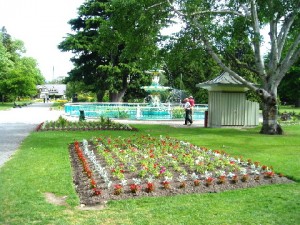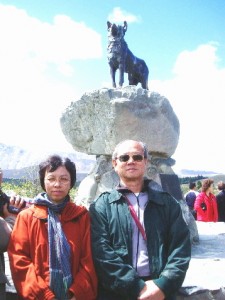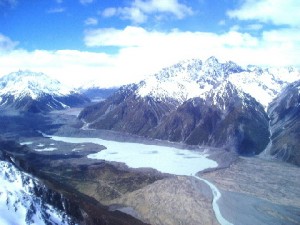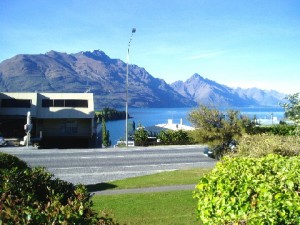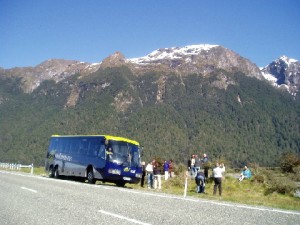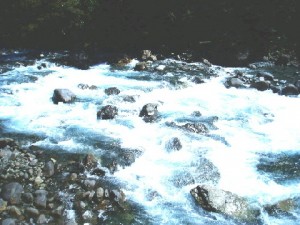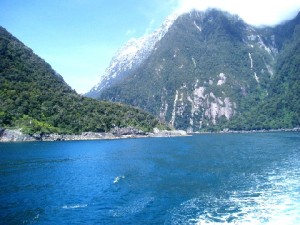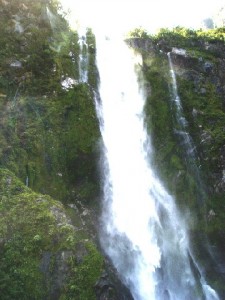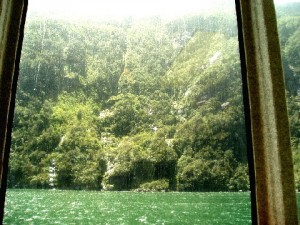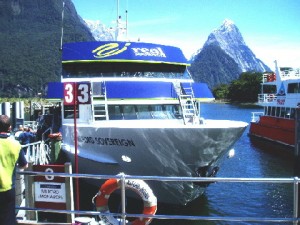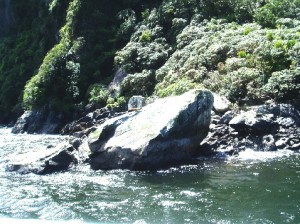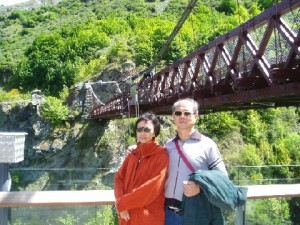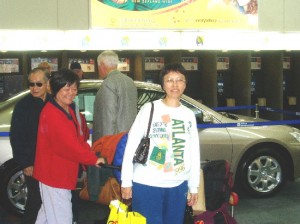New Zealand Travel
New Zealand Travel
To any tourist, the mere mention of the country, New Zealand, conjures up the images of active volcanic thermal activities in the North Island, millions of sheep grazing in the green pastures, beautiful glacial landscapes and spectacular fiords in the South Island. (See map of New Zealand on the right)
It was in 2003 that my wife and I decided to make our first overseas tour together. The first country we agreed to visit was New Zealand. We wanted to see for ourselves those wonderful things we had read about in Geography textbooks during our school days. It would be my maiden trip to a distant foreign country.
Below is the Itinerary of our New Zealand Travel:
Day 1 Air Travel To New Zealand
Day 2 Auckland City Tour
Day 3 A Kiwi Fruit Farm / Waitomo Caves / Rotorua City Tour / Rotorua Museum
Day 4 Whakarewarewa Thermal / Reserve / Rainbow Springs / Agrodome
Day 5 Christchurch City Tour
Day 6 Journey to Queenstown / Queenstown
Day 7 Travel to Milford Sound / Milford Sound Boat Cruise
Day 8 Travel Back to Christchurch
Day 9 Travel Back Home
Day 1 : 12 Nov 2003 Air Travel To New Zealand
On 12 November 2003, we boarded a New Zealand airline at Singapore Changi International Airport. We knew that it would be a very long journey to our destination. The non-stop flight would take 10 hours.
We boarded the plane and soon it was moving slowly on the runway. Then it started to accelerate. As it was moving fast, I could feel light thuds of the floor. It must be due to the wheels running over narrow gaps in the runway. At the same time, I felt my body pressing against my seat.
When the plane had gathered enough speed, the flap of the left wing (I saw it outside my window) moved downwards slowly and the plane finally lifted off the ground. It front tilted upwards at an angle soaring loudly into the air. I saw a pretty air-stewardess who was sitting in front of me a few metres away higher than me as the plane was climbing steeply. Several minutes later, it was flying at a height of about 8,000 metres above sea-level (which was shown in the screen). Finally, it was moving horizontally. At such a height, my ears had a strange feeling. I could not hear clearly what my wife sitting next to me was saying. Then I realized that the air pressure inside the plane had dropped. To overcome the problem, I swallowed some saliva to equalize the pressures on both sides of my ear-drums. Frankly speaking, that was my first flying experience.
Inside the plane, out of curiosity, I looked around me. I noticed that the plane was full of passengers of different nationalities. Most of them, I thought, were tourists who wanted to visit New Zealand, a well-known tourist destination.
Every few hours, the hard-working air-stewardesses would push trolleys of food and drinks for the passengers down the narrow aisles. At such times, it would be difficult to go to toilets as the passageways were narrow. There was plenty of food to eat and beverages to drink. If a passenger was asleep during a meal-time, he might miss his meal.
On the journey, I felt uncomfortable to sit for long hours in a seat which had very little room for my legs to stretch. I slept very little as I am not used to sleeping in a seat which can only incline slightly. Most of my time was spent on watching movies, listening to songs, reading free newspapers and magazines, and looking at maps on a small screen which showed data of the flight such as height, speed, flight-route and the temperature outside the plane. I was wondering how these readings could be recorded and shown instantly.
Man is a genius I marvel at one of the man’s great inventions, i.e. flying machines. They are not only heavy themselves but able to carry a lot of people. Besides, they can speed over 800 km per hour making our world seem smaller.
Day 2 : 13 Nov 2003 Auckland City Tour
Ten hours later, the plane touched down safely at Auckland Airport at 11.30 am (Auckland local time). It was a smooth but long flight. At the airport, we went through the strict immigration and custom checks. We were asked whether we had brought in meat and fruits from our countries. The officers were polite but looked serious. It would make a lot of difference if they could give us a smile.
When we came out of the checkpoints, we saw a pretty Chinese lady holding a card with my name written on it. I went up to her and identified myself. She was actually our tour agent. She told us to go to a coach and join 11 Malaysian tourists who arrived a day earlier (see photo on the right).
After a sumptuous lunch at a restaurant in the downtown, the coach driver brought us round to see Auckland City. It was a cloudy and windy day with occasional drizzles. But the anxiety to see the city made us forget the bad weather condition.
Auckland Auckland is a vibrant cosmopolitan city. It is the largest city in New Zealand and a home to 1.2 million people of different races of diverse cultures and religions. It sits astride a narrow isthmus with the Tasman Sea in the west and the Pacific Ocean in the east. The views of the two harbours, Waitemata and Manukau, are spectacular.
Auckland is rich in maritime history and it is known as the “City of Sails”. To live up to its name, it holds a world sailing competition annually.
In the hub of Auckland is the vibrant central business district (CBD). It is sited around the famous street, Queen Street. In this area, there are many tall buildings but the most prominent landmark is Sky Tower which rises 328 metres above the street. It is in fact the Southern Hemisphere’s tallest free standing structure. One can take an elevator up the tower and have a superb view of the city and harbour.
If you are an adventurous thrill-seeker, you can take an adrenalin-pumping plunge from a platform 192 m high. Auckland offers many other good attractions such as Sky City, the American Express Viaduct Harbour, Auckland Zoo, Parnell Village and Underwater World.
Mount Eden and other attractions Mount Eden was the first place we visited. There we could see a splendid panoramic view of the city and harbour.
On this hill there was a war memorial in memory of the fallen heroes in World War II (see photo on the left). Then we travelled to Parnell Rose Garden where we feasted our eyes on the beauty of about 300 types of roses. Later, we visited the American Express Viaduct Harbour where yachts of different sizes belonging to different nationalities were berthed. From that place we could see a long harbour bridge which links Auckland City in the south to Northcote in the north.
Day 3: 14 November 2003 A Kiwi Fruit Farm / Waitomo Caves / Rotorua City Tour
A Kiwi Fruit Farm
On the way to Waitomo Caves, we stopped at a kiwi fruit farm. The kiwi fruits, at that time, were small and greenish on the plants which were supported by props. Fortunately, we could find ripe ones for sale in the farm shop. Kiwi fruits are brownish with a hairy skin. They are slightly bigger than a duck’s egg. They are quite juicy but not very sweet. Strolling in the farm behind the fruit shop, I was attracted to an old broken-down farm tractor with a manufacturer’s name “Fordson”. I was so fascinated by it that I climbed onto it and sat on it with joy. Then I asked my wife to take a photo of me pretending to drive the machine.
As there was nothing much to see at the farm, we spent a short time there and continued our journey to Waitomo Caves.
Waitomo Caves When we arrived at the caves, we were greeted by a guide who told us that the region has an amazing network of limestone caves and grottos. She then led us into a dimly-lit cave to admire the spectacular
limestone structures of different shapes and sizes sculptured by Mother Nature for millions of years. Each structure has a living or non-living form which is given a name. All these are actually stalactites and stalagmites.
Glow-worms Then we took a slow and quiet boat ride into the green “starry” world of glow-worms in a grotto. As we glided silently through it, we were awe-struck by hundreds of thousands of tiny green lights looking like stars on the roof-ceiling.
Glow-worms are actually not worms. They are larvae of small fungus-gnats (Arachnocampa Luminosa) which emit green lights to attract their preys like midges or other flying insects. When an unsuspecting victim flies towards the light it gets caught among the glow-worm’s sticky strands hanging down from the ceiling of the cave. Then the worm pulls up the poor soul and feeds on it.
Later, we left Waitomo Caves and headed east for Rotorua City.
Rotorua City Tour On arrival at Rotorua city, we checked in at a hotel known as Lake Plaza Hotel. We were surprised to see steam together with a smelly gas like a rotten egg coming out of the ground continuously around the hotel. The hotel is located near a lake which gives out the same smelly gas. It is due to volcanic thermal activity in the ground. We had no choice but to tolerate the smell during our stay there.
In the afternoon, we went sightseeing in Rotorua City. For a better panoramic view of the city, we went to the top of Mount Ngongotaha where
we could see the city at the edge of Lake Rotorua and a small island, Mokoia, in the middle of the lake.
Rotorua City Rotorua City is in the middle of the Central North Island’s volcanic plateau. It is an area of intense volcanic thermal activity. There are 14 lakes surrounding the city. They provide excellent trout fishing, boating and camping activities. Besides, the scenery is beautiful.
Rotorua is rich in Maori history and culture. The original settlers in Rotorua, the Maoris, were attracted to the hot thermal water which they could use for bathing and cooking. The place which has sizzling volcanic thermal activity is now a popular tourist spot.
The Rotorua Museum The Rotorua Museum is located in the Government Gardens (see photo on the right). The building has a beautiful Tudor architectural style. It is a place where one can learn about Rotorua’s great stories of the past and present.
In the evening, while we were having a hearty Maori Hangi feast (a Maori traditionally prepared food) at the Lake Plaza restaurant, we were entertained to a cultural concert performed by the Maoris in their traditional clothes with colourful and intricate designs. While the male Maoris were performing a war dance, Haka, they would shout, haka, and stick out their long tongues many times. Whenever they did that we had a great laugh. We were amazed to see pretty female performers doing a poi dance. Poi is a ball with a short string attached to it. As the ladies were dancing they sang their folk songs and kept swinging their pois rhythmically.
Day 4 : 15 Nov 2003
Whakarewarewa Thermal Reserve Having taken our breakfast at the Lake Plaza Hotel in Rotorua City, we travelled to the Whakarewarewa Thermal Reserve. When we arrived there, we took a walk round the area and were amazed to see hot boiling
mud, the awesome 30-metre high Pohutu Geyser which burst into life 10 to 20 times a day, hot silicaterraces and the unique geothermal vegetation. Then we entered a Maori Village to see native arts and crafts and learn about their rich culture and history.
Rainbow Springs Our next stop was the Rainbow Springs which is 6 km from Rotorua. It is a place where native bush, ferns, trees and plants are grown.
This place has many aviaries and offers a guided walk to look out for native birds in the aviaries, such as North Island Kaka, South Island Kea, Tiri, Kereru, Paradise Duck and many more. Besides birds, one can see native lizards, e.g. the Gecko and Skinkas well as trouts. Among the trouts are Rainbow, Brown and Tiger. They cruise in the crystal-clear, cold water in the fern-fringed pools at Rainbow Springs. Water flows into the pools continuously from subterranean springs.
Kiwis Then we went to see adult kiwis (New Zealand national icon) in a specially designed dark house nearby. Kiwis are nocturnal creatures which are as big as a domestic fowl. They have a long slender bill and covered with coarse hair-like feathers. As their wings are small they are unable to fly. They like to eat worms, insects, grubs, leaves, berries, etc. Their natural habitats are native forests, scrubs and grasslands. Eggs from the wild are collected, incubated and hatched at Rainbow Springs. When the chicks are big they are released in the wild. This is to ensure that kiwis do not become extinct. Five kinds of kiwis are found in New Zealand. Among them are Brown Kiwi, the Little Spotted Kiwi and the Great Spotted Kiwi.
Agrodome From Rainbow Springs, we travelled to the Agrodome to watch an hour-long sheep show in a huge auditorium with 800 seats. The show included a parade of 19 breeds of sheep (Romney, Drysdale, Perendale, Merino, Cheviot, etc.) (see photo on the right), a sheep shearing demonstration by a top shearer, hand milking of a cow by tourists, demonstration by Huntaway dogs and an opportunity for tourists to feed lambs with milk in large bottles on the large stage. We enjoyed the show very much as it was entertaining and hilarious.
In front of the auditorium is a building which has a very old and large machine. It is a woolen mill manufactured in 1906. It is still functioning. An elderly man demonstrated and explained the working of the noisy antique machine. Besides, he gave us an interesting detailed account of New Zealand wool history.
As it was getting late we were unable to explore the other interesting areas of the farm at Agrodome. So we travelled back to our hotel at Rotorua city.
Day 5 : 16 Nov 2003 Flying to Christchurch
In the afternoon, we departed Rotorua by plane and travelled south to Christchurch in South Island. While the plane was flying to Christchurch, I could see the clear eastern coastline of New Zealand South Island, the snow-capped mountains of the Southern Alps in the western island and the wide blue expanses of the Pacific Ocean below the plane.
After travelling for 2 hours, we finally landed at the Christchurch International Airport. It was a smooth flight. Then we stepped out of the plane. As we were walking towards the airport terminal, cold wind from the Pacific Ocean was blowing strongly towards us and we were struggling to reach the terminal.
Christchurch Sightseeing Tour
Cashmere Hill After going through the immigration, security and custom checks at the Christchurch Airport we boarded a small tour coach and headed to the vantage point of Cashmere Hill, where we could see the wide Canterbury Plains and Christchurch City.
Christchurch Christchurch is the 2nd. largest city in New Zealand. It perches on the coast with the Southern Alps in the west as a backdrop and bordered by the Pacific Ocean in the east. It is the gateway to the large Canterbury Plains spreading westwards towards the mountains. The city has a population of over 340,000. Over 80% of the population is Europeans, 7% Maoris, 5% Asians and the rest are other ethnic groups.
The city is dissected by the crystal-clear meandering Avon and Heathcote rivers which give the charm reminiscent of the English cities from where its first inhabitants emigrated. One can go punting in Avon River with its grassy banks lined by trees such as poplars and weeping willows.
As much of the city landscape is devoted to parks, natural reserves and recreation grounds, it has earned an International Garden City award.
Cathedral Square The coach then brought us to Chistchurch city where we walked around Cathedral Square and saw the most visible and well-known historic building, Christchurch Cathedral. It is one of the finest examples of Gothic Provincial architecture in New Zealand.
Chalice Standing in the centre of the Square is a tall, unique metallic structure called Chalice. It is a metallic work of art in the shape of an inverted cone with a perforated network of 42 leaf patterns depicting the leaves of native trees. It stands 18 metres high and is designed by a well-known sculptor, Neil Dawson. Chalice celebrates the new millennium and the 150th. anniversary of the founding of Christchurch and Canterbury by the Canterbury Association.
Flea Market Strolling down Worcester Blvd., we saw a tram-car which follows the inner city route. Along the route, passengers will enjoy the sights and sounds of the city.
We visited a flea market near the Art Centre which is a historic building. At the market, stalls which were mostly run by senior citizens were selling souvenirs, arts and handicrafts, antiques, clothes, paintings, food, beverages and many more. Then we visited Canterbury Museum which is another historic building.
Canterbury Museum In Canterbury Museum, one learns about stories of Pacific migration, the moe-hunter Maori, the European settlers and the flora and fauna of the region. Besides, it houses spectacular fossils, decorative arts and costumes collection, the Bird Hall and the world’s most important collection of Antarctic items. The admission is surprisingly free of charge but donations are encouraged.
Botanic Garden Near the museum is the Botanic Garden where both exotic and native trees, shrubs and plants are grown. Besides, it has roses and water plants, and a rockery. A beautiful blue fountain can be seen in the garden. The garden is serene and its air is clean and refreshing.
Day 6 : 17 Nov 2003 Journey To Queenstown
In the morning, we made a long journey by coach from Christchurch to Queenstown. Travelling south-west, we saw lots of sheep grazing in the pastures. New Zealand has 45 million sheep and is one of the world’s biggest wool producers. As New Zealand has a human population of 4 millions, the sheep outnumber the country’s human population by more than 11 to one.
Lake Tekapo Town After about 3 hours of travelling we reached Lake Tekapo Town where we stopped for lunch. Then we continued our travel to a lake, Lake Tekapo. When we arrived there we were amazed to see a milky green hue in the lake. It is caused by finely ground rock particles crushed by glaciers deep in the Southern
Divide that feeds it. At the lake, our faces felt the cold icy wind blowing strongly from the snow-capped mountains in the west. The view of the snow-capped mountains in the Southern Alps was breathtaking. Among them is New Zealand’s highest peak, Mount Cook or Aoraki (3,754 m).
Church of the Good Shepard Near Lake Tekapo stands a little stone-church, Church of the Good Shepard, with a statue of a dog nearby. The church was built as a memorial to early pastoralists and their best friend, the working dog, was immortalized in the statue.
Mount Cook National Park Then we headed to the Mount Cook National Park. When we arrived there, my wife and a few tourists took a scenic helicopter flight over an amazing region of snowfields, glaciers and snow-capped mountains.
When the helicopter landed on a snowfield high above sea-level, the passengers stepped out of the helicopter excitedly. They saw Mount Cook (3,754 m), New Zealand’s highest peak, in the distance and the U-shaped valleys that have been carved out by glaciers thousands of years ago. Some of these valleys have lakes with rivers flowing into them. They also saw snow-capped mountains with hanging
valleys. Later, my wife told me repeatedly that the views of the landscapes from the high ground were spectacular. She also told me that they enjoyed playing in the snowfield where the helicopter landed as our country, Malaysia, has no snow. That was an unforgettable and worthwhile experience for my wife even though it burned a big hole in her pocket.
Queenstown After the visit to Mount Cook National Park, we moved south to Omarama and then south-west to Queenstown. That was a three-and-a-half hour journey from Christchurch. On arrival at Queenstown, we checked in at a hotel which overlooked Lake Wakatipu.
Queenstown is a small town. It nestles under Remarkable Mountains Range and is on the shore of Lake Wakatipu. This lake is long and narrow and is in a shape of an S.
Queenstown was once a booming gold town. But now it is a popular tourist resort. It is a mecca for thrill-seekers. They can make bungy plunge off a bridge, ride the Jet Shotover River in a high speed jet-boat, raft the region’s wild rivers, skydive, ski in the nearby mountains in winter and indulge in other exciting and adventurous activities. Tourists who do not like these exciting adventures may board the vintage steamship, TSS Earnslaw, and enjoy the beautiful sights of Lake Wakatipu.
Filming of “The Lords of the Rings’ Trilogy” We were told that some of the locations around Queenstown were used in the filming of “The Lords of the Rings’ Trilogy”, e.g. Glenorchy, Kawarau River, Te Anau, Deer Park Heights, Mavora Lake and Dart River. It must be its natural, unspoilt landscapes suitable for the story.
As Queenstown is a small town, it took us a short time to walk in all its streets. It is amazing that in such a little town there is a casino and a foreign currency exchange shop. After strolling in the streets, we decided to browse at shops selling souvenirs, postcards, T-shirts with colourful designs, and other merchandise. Later we relaxed by the lake, admiring the beautiful scenery round the lake and watching small planes flying tourists to the sky for aerial sightseeing. Then we walked back to our hotel which was a few hundred metres from the town and it was a good exercise for us.
Day 7 : 18 Nov 2003 Journey to Milford Sound
In the morning, we left for Milford Sound where we wanted to see the well-known scenic fiords. We travelled in a blue luxury coach with a glass-roof that offered a larger view outside. Besides, its front could be raised as it went up a steep slope or lowered when it moved down.
Lake Wakatipu While our coach was travelling south from Queenstown it moved slowly along a narrow road with vertical steep slopes on one side and Lake Wakatipu a few metres away on the other. After the
lake, the scenery is transformed into high pastures surrounded by mountains and then serenely beautiful farm country of the Northern Southland Plains. As we travelled westwards towards a small town, Te Anau, we passed by some crystal-clear streams.
Te Anau Soon we reached Te Anau, and stopped there for some refreshments. An hour later we continued our journey to the north. Not long, we entered The Fiordland National Park which is a world heritage area. It has some of the most spectacular scenic splendours
of the world.
Homer Tunnel From the Eglinton Valley with its endless golden tussock pastures, we travelled into beach forests and past tranquil lakes and crystal clear streams. We also climbed steadily into the very heart of the mountains. In the mountainous region we came across a long tunnel, Homer Tunnel, which is the gateway to Milford Sound. It is 1,219 metres long and was officially opened in 1954.
The tunnel is narrow and has a single lane. If two vehicles happen to travel in opposite directions inside the the tunnel, one of them has to stop very close to the side allowing the other to pass by.
After passing through the tunnel our coach stopped at a place near the tunnel. We came out of the coach and enjoyed the beautiful scenery of snow-capped mountains and valleys. Although it was a sunny day, the wind blowing from the snow-capped mountains was dry and cooling. Further down the road was a stream. Its water was crystal clear and cold. Soon we were travelling again. Finally, we reached Milford Sound.
Milford Sound Boat Cruise Milford Sound is a 22 km-long fiord which was created by moving glaciers during the Ice ages. It is dominated by Mitre Peak (1,683 m). Some have described Milford Sound as the 8th. Wonder of the World.
When we arrived at Milford Sound, the weather was sunny and the cold wind was blowing from the Pacific Ocean, continuously. We boarded a cruise boat and soon we were on our way to see one of the world’s stunning landscapes, the Milford Sound fiord.
While the boat was cruising in the fiord, we had close-up views of Mitre Peak, luxuriant rainforest which was clinging to sheer rock walls and cascading waterfalls. The sights of all these were awe-inspiring and invigorating. On one occasion, the boat went very
close to a spectacular waterfall, Stirling Falls.
Seals and Dolphins When the boat had cruised several hundreds of metres away from the seashore we spotted some seals basking on some rocks and later a few dolphins swimming close to each other towards the vast ocean.
After the unforgettable boat cruise in Milford Sound we returned to Queenstown.
Day 8 : 19 Nov 2003 Travel Back To Christchurch
Shotover Jet Boat Ride In the morning, we had a last peek at Queenstown. Then we travelled to Shotover River Canyons where we had a thrilling and adrenalin-pumping experience in a Shotover Jet boat ride. We screamed as it sped past rocky outcrops with only a few centimetres to spare, twisted through narrow canyons and made three awesome 360 degree spins. It took several years for the expert of the boat to
master the spin. When the boat returned to the jetty we were feeling dazed. Luckily, our clothes were not wet as we were wearing borrowed rain-coats during the rough ride.
Arrowtown After that screaming experience in the canyons, we travelled to Arrowtown which was once a booming gold-mining area. In this little
town, the heritage is fiercely protected. Many of the original 19th. Century quaint stone-buildings still remain perfectly preserved and in daily use. We were told that we could hire a gold-pan and pan for gold in the river nearby. But none of us was interested in getting gold there.
Bungy Jumps The next destination was a place where tourists could do bungy jumps into a deep canyon. When we arrived there, it was lunch-time and the workers had gone for their meals. We could not wait for another hour for the jump to commence again, as we had to travel northeast to a town to have a prearranged lunch. We disappointedly left the place without a chance to experience the jump.
In the evening we arrived at Christchurch. Shortly after dinner, we walked along Colombo Street in the city and shopped for some souvenirs.
Day 9 : 20 Nov 2003 Travel Home (Malaysia)
We woke up early in the morning and had breakfast at a hotel restaurant in Christchurch. Then we left for the Christchurch airport. At 10.30 am (New Zealand local time), we left the airport on a domestic flight to
Auckland. Arriving at Auckland, we boarded a larger plane. At 6.50 pm (Auckland local time), we finally left New Zealand for a long, long journey home.
While flying in the air, I was reminiscing about the whole tour that I had enjoyed every moment in New Zealand. As this tour is my first overseas experience I will always remember it with fond memory. I am now beginning to like overseas tours and planning to make more before my old legs start to give me trouble.
Thanks for reading my New Zealand travelogue and I hope you have enjoyed it.
Written by Choo Chaw, Kluang, Johor, Malaysia.

